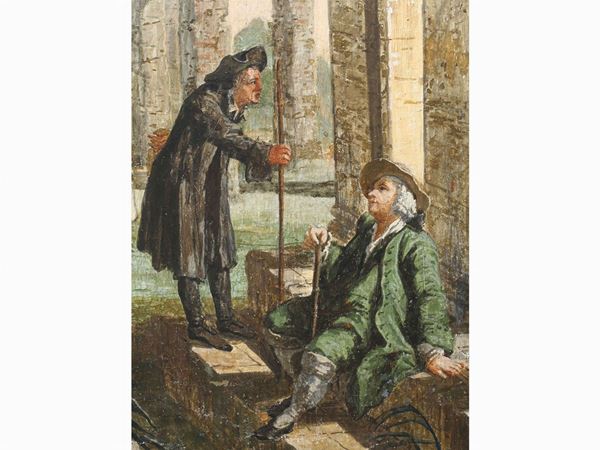Lot N. 235
Giuseppe Zocchi (1711 - 1767)
Two figures talking and ruins
(1715?-1767)
oil on canvas laid on wooden door, some defects
tela cm 207x93,5, porta cm 237x125
The following technical sheet of the work was created by Professor Sandro Bellesi as part of the inventory of the paintings of the Fattoria Franceschini. The work is part of a group of paintings, executed as internal ornamental elements for six wooden doors, depicting, with highly scenographic intentions of theatrical taste, characters of various kinds portrayed mostly near the ruins of ancient architectural vestiges. In a good state of conservation, the works, defined with considerable inventive flair in the conception of the ruins, are the result of careful reflections based essentially on the so-called "whims", a term with which in the late Baroque era they were indicated, among other meanings, mainly wall paintings, but also easel paintings, in which views with figures appeared in the vicinity of architectural ruins or fantastic constructions. Thanks to the style characters and some historical memories handed down in the bibliographic sources, it is possible to assign this group of paintings, documented ab antiquo in the Villa Pitti in Lastra a Signa, to Giuseppe Zocchi, one of the most interesting artistic figures active in Tuscany in the "Century of Lumi ". Probably born in Florence on March 18, 1715, Giuseppe Zocchi, belonging to a family of humble origins, was initially initiated into the activity of a bricklayer, or rather a laborer. During one of his assignments, Zocchi was noticed by the painter Ranieri Del Pace, who, having admired in the young man a good propensity for painting, wanted him as his pupil and collaborator. Thanks to the support of the Marquis Andrea Gerini, the artist was then able to complete his extra-moenia training, making study trips to Rome, Bologna and Venice. In 1741, shortly after his return to his homeland, he enrolled at the Academy of Drawing and more or less at the same time he had to start his own independent professional activity, initially linked to both the field of painting and that of 'engraving. The execution of the series of etchings dedicated to the most pleasant views of the city of Florence and to the country villas belonging to the Tuscan aristocracy, from which the artist drew inspiration, on several occasions, for various pictorial representations dates back to the same decade. Much appreciated especially in the field of paintings on canvas and in large fresco cycles, Zocchi is documented since the early 1950s as a supplier, among other assignments, of numerous models destined for the Opificio delle Pietre Dure, supervised by Louis at that time. Siriés. Much loved by the Grand Dukes of Tuscany and by the Florentine noble families, Zocchi died, full of honors, in the City of Giglio in 1767. This series of paintings, based on the stylistic data and documentary reports to which we have already mentioned, appears to be assignable to the artist's youthful phase, that is to the end of the 1830s, as evidenced by the lack of a typological figure that is still not well distinct in the definition of the characters, for which the intervention of different authors is not excluded in some cases, authors strongly marked by the teachings of Ranieri Del Pace but also of Ottaviano Dandini and other Florentine masters appreciated at that time. Probably coming into contact with the Pitti family at the time of his collaboration with Del Pace in relation to a cycle of frescoes painted in Lastra a Signa, Zocchi is actually mentioned in the second volume of the Supplement to the Series of the Three Hundred Praise and Portraits of Men the most illustrious... of 1776, in connection with the knight Luigi Pitti, an amateur painter appreciated by the grand ducal court. For the home of Pitti Zocchi he created various murals with architectural ruins and through the support of these he obtained the commission for the execution of a pictorial cycle in the Teatro del Cocomero in Florence, today the Niccolini Theater.
Literature: S. Bellesi, Personaggi, architetture, rovine archeologiche e paesaggi nella pittura fiorentina del Settecento al tempo dei Lorena, in M. Ciampolini [ed.], Goya, Boucher, Ricci, Batoni e i maestri del '700 nelle città del Cybei, Milano 2021, pp 106-113
Literature: S. Bellesi, Personaggi, architetture, rovine archeologiche e paesaggi nella pittura fiorentina del Settecento al tempo dei Lorena, in M. Ciampolini [ed.], Goya, Boucher, Ricci, Batoni e i maestri del '700 nelle città del Cybei, Milano 2021, pp 106-113
€ 5.000,00 / 8.000,00
Estimate
Unsold










